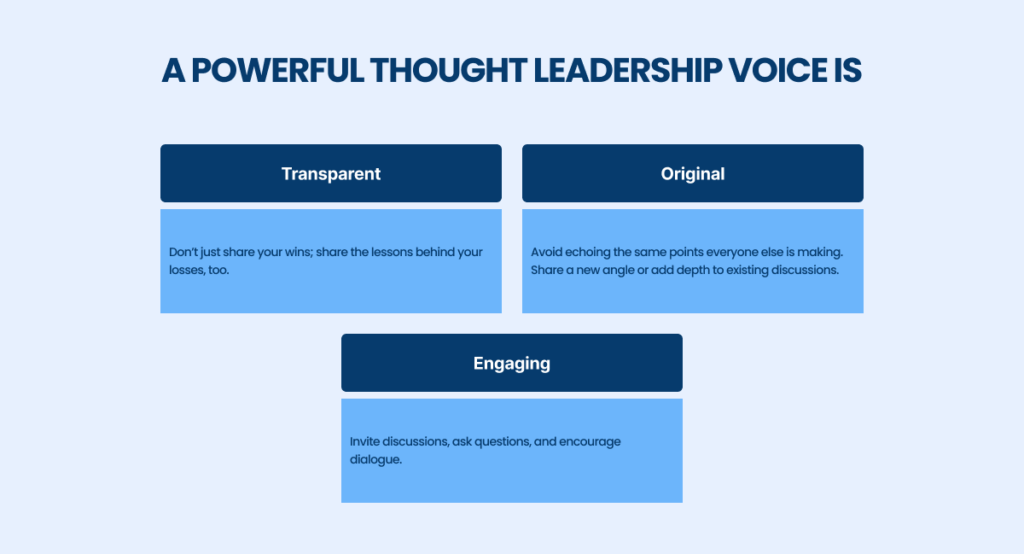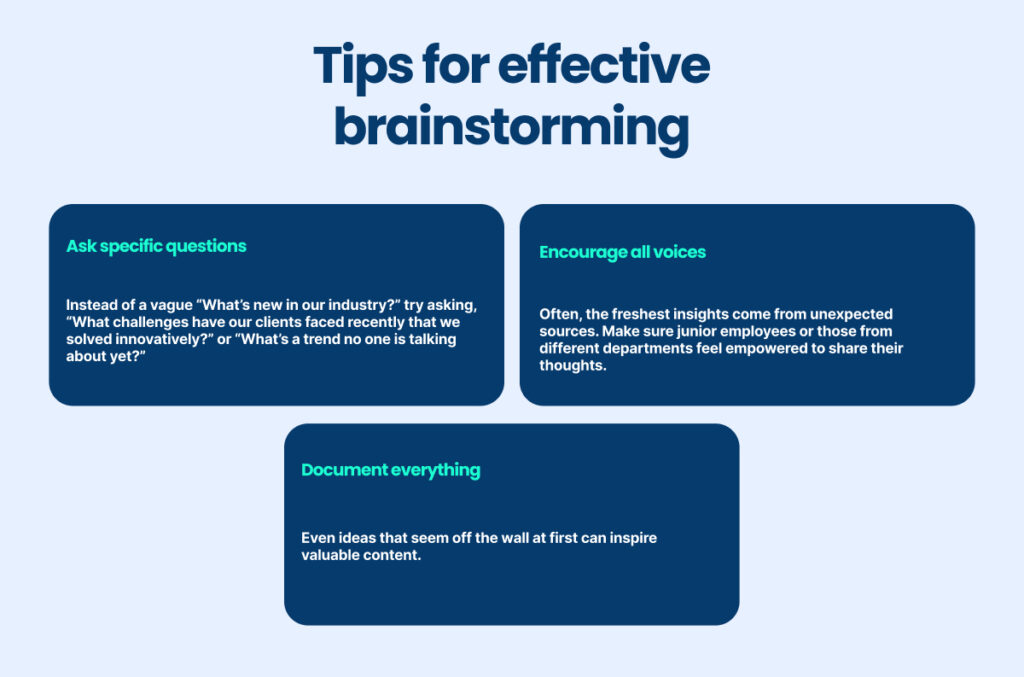“People wake up thinking about their problems, not your product. Great thought leadership speaks to those problems and positions your insights as the answer, explains Mina Seetharaman, Chief Strategy and Creative Officer at The Economist.
We should understand that thought leadership is not just content creation but strategic, insightful, and impactful contributions to industry dialogues.
By positioning ourselves as thought leaders, we’re sharing more than just information. We’re shaping the future of our industry.
It’s about identifying the critical questions, providing innovative solutions, and inspiring action.
Thus, our goal isn’t merely to be heard but to be influential.

As a result, 65% of businesses already include thought leadership in their content marketing.
The strategy can be well-defined and correctly inserted if a quality Thought Leadership Agency provides relevant assistance.
To understand the full impact of Thought Leadership, let’s dive into the detailed study.
Thought Leadership Is More Than Just a Buzzword
When someone mentions thought leadership, it’s easy to brush it off as another marketing term that’s lost its meaning in the shuffle of business jargon.
But what is thought leadership really, and why does it matter for CEOs and business owners?
If approached with genuine intent and strategy, thought leadership can elevate a brand from just another player in the field to an industry pioneer.
What Is Thought Leadership, Really?
Think of thought leadership as more than just publishing content or speaking at conferences.
It’s the art of becoming a trusted voice, the go-to person in your field who is recognized not only for knowledge but for insightful and innovative thinking.
As a business owner or CEO, this means sharing your expertise in a way that shapes industry conversations, sparks new ideas, and sets trends.
Source: Semrush
Thought leadership marketing isn’t about pushing your products or services. Instead, it’s about providing value—giving your audience a fresh perspective backed by authentic experiences and data-driven insights.
It’s the difference between saying, “We’re good at what we do,” and demonstrating why you’re an authority through the unique insights you bring to the table.
Why Thought Leadership Matters for CEOs and Business Owners
Brand reputation is everything. In a marketplace brimming with competition, being seen as an industry authority can mean the difference between being just another name and becoming a recognized leader.
Thought leadership positions you at the forefront of conversations that matter most to your field.
For CEOs and business owners, this goes beyond reputation management—it’s about fostering trust, gaining influence, and opening doors that wouldn’t be accessible otherwise.
The Transformative Power of True Thought Leadership
Imagine two brands in the same industry.
One consistently pushes promotional content that screams “buy, buy, buy,” while the other shares thoughtful insights, data-backed reports, and actionable advice. Which one would you follow? Which one would you trust? The answer is clear.
Thought leadership doesn’t just enhance brand reputation; it redefines it. By sharing your experiences, highlighting challenges, and presenting new solutions, you become part of your audience’s learning journey.
And here’s the best part: you’re not just leading the conversation—you’re shaping it.
Thought Leadership vs. Content Marketing: What’s the Real Difference?
At first glance, if you consider what thought leadership is and what content marketing is, we should clarify that they might seem interchangeable.
Both involve creating content that promotes a brand’s expertise, both aim to engage audiences, and both can be strategic tools for growth.
But here’s where it gets interesting: while they share similarities, their purposes diverge in impactful ways.
Thought leadership targets the future and inspires larger industry change. It positions CEOs and business owners as visionaries, shaping conversations, challenging norms, and setting new standards.
It’s about addressing questions that haven’t been asked yet, opening discussions on uncharted topics, and sparking new ways of thinking. Thought leadership isn’t just about promoting what’s happening now; it’s about leading the narrative into what’s next.
Content marketing, on the other hand, is more immediate. Its primary goal is to address the current needs of a business, align with specific products or services, and drive conversions.
Think of content marketing as the voice that engages prospects and customers through guides, how-tos, and product showcases. It answers questions like, “How can this solve my problem today?” rather than, “What changes are coming that I should prepare for?”
Source: Semrush
Breaking Down the Differences
| Aspect | Thought Leadership | Content Marketing |
| Objective | Aims to position a leader or brand as an authority and pioneer in their industry, driving discussions and fostering deep trust. | Seeks to inform, educate, and convert potential customers by addressing their present needs. |
| Audience Impact | Creates long-term relationships by establishing a brand reputation, elevating the perception of CEOs and business owners as forward-thinkers. | Appeals to customers who are ready to make a purchase or need practical information. |
| Approach and Style | Research-driven, opinionated, and showcases original ideas. Draws from personal experiences, industry insights, and forecasts trends. Examples include in-depth articles or panels on future digital transformation leadership. | Relies on SEO-optimized blog posts, product comparisons, and email campaigns that educate and drive immediate actions. |
The Power of Perspective: How to Develop a Unique Thought Leadership Voice
Every industry is filled with voices.
But what makes a voice stand out is perspective. For CEOs and business owners, developing a unique thought leadership voice can transform your brand from another name in the industry to a trusted and admired leader.
Start with Authenticity
Authenticity isn’t just a buzzword; it’s the foundation of effective thought leadership marketing. Audiences today are savvy—they can sense when a piece of content is purely promotional or lacks genuine insight.
Being authentic means showing up as a leader with all the lessons learned, including the tough ones. Why? Because people connect with people, not perfection.
Your personal journey plays a significant role here. Sharing challenges, failures, and breakthroughs makes your insights relatable.
For instance, a CEO discussing how their company navigated a digital transformation during a critical growth period can highlight both the missteps and the lessons learned. This type of content goes beyond simple advice—it becomes a story of resilience and innovation that others can learn from.
Tip: If you’re looking to start, consider discussing key turning points in your career that taught you the most valuable lessons. These stories humanize your brand and make your audience feel like they’re learning from someone who has been in their shoes.
Staying Genuine to Build Connections
Authenticity also builds trust, which is crucial in establishing a brand reputation. CEOs who use thought leadership to talk candidly about trends, forecast industry shifts, or share exclusive research don’t just inform their audience—they create a bond.
This is where authority marketing comes in. By consistently providing valuable and honest insights, you establish your voice as one that people return to.
Remember, how to become a thought leader isn’t just about posting content; it’s about leading with integrity. A powerful thought leadership voice is:

Standing Out in the Noise: Strategies for Uncovering Your Unique Angle
In an era where everyone has a voice, finding your unique perspective is crucial. For CEOs and business owners, this isn’t just about being heard—it’s about resonating with your audience and building long-term trust.
So, how do you develop an authentic voice in a crowded space? Here’s how to uncover your unique angle.
1. Conduct Internal Brainstorming Sessions for Proprietary Insights
One of the most effective strategies for creating standout content is conducting brainstorming sessions with your team.
You’d be surprised how many hidden gems of insight are within your organization. Gather a diverse group—ranging from senior leaders to newer employees—and create a space where ideas can flow freely.

When you pull insights directly from your team’s experiences, you can create content that’s not only unique but inherently tied to your brand reputation and company culture.
2. Use Personal Experiences to Humanize Your Content
For a CEO or business owner, your personal journey can be a goldmine of thought leadership material.
People are drawn to stories that show the human side of success—failures, lessons learned, and the moments that shaped your leadership style.
Why personal stories work:
- Authenticity builds trust: Sharing your own struggles and triumphs helps establish a connection. Your audience can see that you’re more than just an expert; you’re someone who’s been in the trenches and come out wiser.
- Memorability: Stories are easier to remember than plain data or facts. When your audience recalls your anecdote, they’ll associate it with your brand and expertise.
Tip: Reflect on experiences that taught you something valuable. For example, if you led your company through a significant pivot during digital transformation, share that. Explain how you navigated challenges, the data that guided your decisions, and the outcome. This enhances your brand credibility and positions you as a thought leader in digital transformation leadership.
Research and Data: The Backbone of Impactful Thought Leadership
If your thought leadership content isn’t supported by solid research, it risks being overlooked as another opinion piece.
In the realm of authority marketing, data-driven insights can elevate your content from interesting to indispensable.
1. Why Research Matters for Thought Leadership
In a world brimming with information, data is what sets true thought leaders apart. It provides the backbone that strengthens your arguments and gives your content substance. By incorporating research, you’re not just telling your audience what to think—you’re showing them why they should trust your viewpoint.
2. How to Effectively Incorporate Research
- Blend statistics with storytelling: Data can be powerful, but only when it’s used effectively. Combine your figures with a narrative to give them context.
For example, instead of saying, “50% of companies struggle with digital transformation,” frame it as: “Half of the companies I’ve worked with faced initial hurdles in digital transformation—here’s how they overcame them.”
- Leverage proprietary data: If your company conducts customer surveys or internal audits, use that information. Proprietary data not only adds unique value but also boosts your brand’s authority.
- Cite reputable sources: Always reference trusted sources, such as industry reports, academic journals, or case studies. This will lend credibility to your content and enhance your brand reputation.
3. Visualize Your Data
Make your data digestible by using infographics, charts, or data visualizations. This isn’t just about aesthetics—visuals can make complex information easier to grasp and more likely to be shared.
For instance, a quick visual representation of how a CEO’s digital transformation efforts led to improved KPIs can resonate more than a lengthy paragraph.
4. The Role of Data in Long-Term Strategy
Consistently publishing data-rich content reinforces your authority over time.
CEOs who frequently incorporate research-driven thought leadership marketing build deeper trust and are perceived as industry pioneers. It’s not just about one article—it’s about creating a library of authoritative content that cements your leadership status.
Harnessing LinkedIn: Your Digital Stage for Thought Leadership
LinkedIn isn’t just a platform for job seekers; it’s a powerhouse for CEOs and business owners to amplify their voices and showcase what is thought leadership in action.
Source: Annual revenue generated by LinkedIn, Statista
Think of it as your own digital stage, where your expertise can be spotlighted to reach thousands of professionals who are eager for insights.
The Power of Engaging Posts
When done right, LinkedIn content marketing can transform a simple thought into a full-fledged industry discussion.
Take, for instance, posts that tell a story—real experiences and relatable scenarios that captivate readers.
An example of successful thought leadership marketing on LinkedIn could be a CEO sharing how their company navigated digital transformation challenges. Such posts often receive high engagement because they offer more than a polished image; they show vulnerability and genuine insight.
Tips for crafting engaging LinkedIn posts:
- Be relatable: Share your own learning moments, even the ones that didn’t end in success. Readers appreciate honesty and lessons learned from failures.
- Ask open-ended questions: Encourage your audience to share their perspectives. For example, a post could end with, “How did your company adapt to digital transformation? I’d love to hear your strategies.”
- Mix up the formats: Don’t stick to text-only posts. Use videos, slide decks, or LinkedIn articles to bring variety and depth to your content.
The Podcast Advantage: Amplifying Your Voice Without the Pitch
Podcasts are like having a one-on-one conversation with your audience but on a grand scale.
For CEOs and business owners, thought leadership examples in the form of podcasts can help amplify your voice without sounding like a sales pitch.
Authentic Storytelling at Its Best
Podcasts allow you to share your journey, experiences, and lessons learned in an authentic, unscripted manner.
Unlike traditional content marketing, which can sometimes feel transactional, podcasts give listeners the opportunity to hear the nuances in your voice, adding a layer of connection that written content can’t always provide.
Why this works:
- Deeper insights: You can dive into topics in more detail, sharing stories behind the numbers or explaining the rationale behind strategic decisions.
- Human touch: When listeners hear the passion or seriousness in your voice, it builds trust. It’s not just about sharing information; it’s about building relationships.
Thought leadership examples include leaders like Reid Hoffman, co-founder of LinkedIn, who hosts “Masters of Scale.” This podcast blends storytelling and data to discuss growth strategies, failures, and the evolving landscape of digital transformation leadership.
The show not only positions Hoffman as an industry pioneer but also as a voice that contributes valuable knowledge without pushing a product or service.
Source: Percentage of consumers who are aware of podcasting, Statista
Podcasts are also an excellent way to complement other authority marketing efforts. When your audience hears you share candid insights about industry growth, they’ll be more inclined to see you as a thought leader who is genuinely invested in progress.
Final Thoughts: Keeping Your Voice Relevant Over Time
Maintaining your relevance as a thought leader isn’t just about making noise but adding unique insights and pushing conversations forward.
What do you need for that? Consistently listen, learn, and refine the message to resonate with the current business climate.
[A] Growth Agency will keep your voice impactful over time and share one key trait: adaptability.
Growth is our driving force. At heart, we’re a team of data-driven growth marketers focused on delivering scalable results.
We understand that being at the forefront of thought leadership means not only anticipating market shifts but crafting strategies.
Thus, we are ready for that.
If you do so, let’s get started together.

